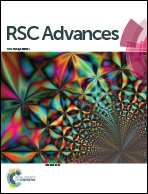Effects of poplar addition on tar formation during the co-pyrolysis of fat coal and poplar at high temperature†
Abstract
Three-stage absorption by butyl acetate was used to obtain tar components during the co-pyrolysis of fat coal and poplar at high temperature. The resulting tar yields were calculated relative to the fat coal and poplar blends. The tar components were characterized by gas chromatography-mass spectrometry, Fourier transform-infrared spectroscopy and 1H nuclear magnetic resonance spectroscopy. The effects of the added poplar on tar formation were then considered. The results show that the poplar–fat coal tar yield rose slightly when the poplar addition levels ranged from 4% to 12% and then increased much more at higher poplar addition levels. Oxygenated and aromatic compounds contributed greatly to the poplar–fat coal tar yield. The quantity of oxygenated components increased in the poplar blending ratio range from 4% to 12% and decreased as the ratio increased further, while the quantity of aromatic components showed the opposite trend. The influences of poplar addition levels on tar formation could be divided into two stages: (a) lighten the tar by stabilizing radicals at low poplar addition levels; (b) form heavier tar due to cross-linking reactions of the remaining radicals at high poplar addition levels. When the poplar addition levels ranged from 4% to 12%, due to synergistic effects, large amounts of free radicals and hydrogen from the co-pyrolysis of coal and poplar formed lighter stable compounds, which were then transported into the tar. Further, cross-linking reactions could be decreased because fewer free radicals and less hydrogen remained. As a result, the amount of PAHs declined, the tar yield rose slightly, the hydrocarbon-generating potential improved, the aliphatic chain length shortened, and the aromatic protons decreased. At higher blending ratios, excess radicals existed after stabilization due to the increasing poplar addition levels. These radicals underwent cross-linking reactions and produced PAHs, resulting in heavily increased tar yields, weakened hydrocarbon-generating potential, extended aliphatic chain lengths and increased aromatic protons.



 Please wait while we load your content...
Please wait while we load your content...